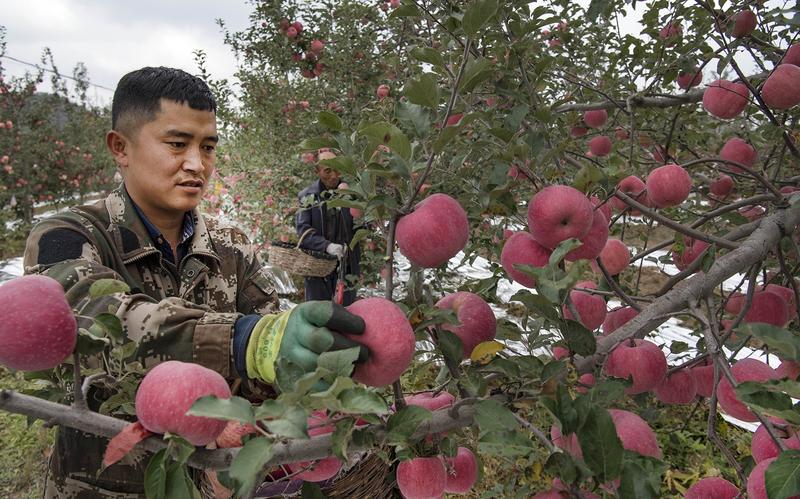Haojiaqiao in Shaanxi draws on revolutionary roots as part of rural vitalization efforts
 A decadelong afforestation campaign has greened barren mountains in Yan'an, Shaanxi province. (TAO MING / XINHUA)
A decadelong afforestation campaign has greened barren mountains in Yan'an, Shaanxi province. (TAO MING / XINHUA)
Editor's Note: China Daily is running a series of stories on old revolutionary bases with profound history and heritage that are striving to lead local people on the road to prosperity in the new era.
In late April, Hao Changhong was busy preparing food at his newly opened homestay-a yard with a few houses reconstructed on cave dwellings in Haojiaqiao village in Suide county, Northwest China's Shaanxi province.
He was busy accommodating batches of tourists who arrived in the village to visit historical sites and experience leisure agriculture such as fruit and vegetable picking.
In recent years, the village has been developing Red tourism to promote rural vitalization. It now features an exhibition hall and the old residences of its historical farming heroes.
 The villagers' committee building (right) and the tourist center stand side by side in Haojiaqiao in Suide county, Shaanxi province. (ZHUANG CHENYANG / FOR CHINA DAILY)
The villagers' committee building (right) and the tourist center stand side by side in Haojiaqiao in Suide county, Shaanxi province. (ZHUANG CHENYANG / FOR CHINA DAILY)
Hao, a 53-year-old native, raised his two sons by cooking outside Haojiaqiao. When he learned about the great changes that were taking place in the village, he decided to return and start a business. With the help of village officials, he renovated his cave house and opened his homestay.
"As a native of Haojiaqiao, I have special feelings for my hometown," he said. "The village has changed a lot, attracting more and more visitors. I believe my homestay has a bright future."
In the 1940s, Haojiaqiao was one of the first villages in the area to see booming grain production. It was part of the Shaanxi-Gansu-Ningxia revolutionary area during the War of Resistance Against Japanese Aggression (1931-45). In 1943, Xi Zhongxun (1913-2002), who was Party chief of Suide, went to the village to continue field research and learned about the production experience of model farmer Liu Yuhou.
Liu's experience was promoted to other villages and set off a production craze, which greatly boosted grain supplies for soldiers and villagers at the revolutionary base.
 A visitor takes photos in one of the village's exhibition rooms depicting revolutionary history. (ZHUANG CHENYANG / FOR CHINA DAILY)
A visitor takes photos in one of the village's exhibition rooms depicting revolutionary history. (ZHUANG CHENYANG / FOR CHINA DAILY)
In recent years, Haojiaqiao has been transformed into a Red tourism site, establishing education and patriotism bases at the old residences and developing local industries to boost rural vitalization.
Migrant workers Ma Bei and Liu Yongsheng returned to the village as the development of Red tourism brought in lots of visitors. The couple rent a booth to sell local specialties, handicrafts, snacks and beverages. "The village had few visitors in the past, but now tourists drive here in groups," Ma said. "We can earn 200 yuan ($30.27) a day in the best-case scenario, and I'm able to take care of my child who studies at the village school."
Since 2018, the village has received more than 240,000 tourists and launched 150 educational activities. Participants have included 12,000 middle and primary students, according to the local government. Apart from Red tourism, Haojiaqiao has been bolstering local industries to increase farmers' incomes.
 Farmers harvest apples in Zhidan county, Shaanxi. Apple growth has become a major industry in the former Shaanxi-Gansu-Ningxia revolutionary area. (TAO MING / XINHUA)
Farmers harvest apples in Zhidan county, Shaanxi. Apple growth has become a major industry in the former Shaanxi-Gansu-Ningxia revolutionary area. (TAO MING / XINHUA)
The village has set up a mountain apple orchard covering 133 hectares, 20 solar greenhouses, 40 arch sheds for storage, a sheep farm with an annual stock of 3,000 sheep, a pig farm and a 500-kilowatt photovoltaic power station.
It also continues to promote new businesses involving golden-and-silver honeysuckles, roses and grapes, the local government said.
Like other villages on the Loess Plateau, sparse trees and loess, a type of sediment, were once commonly seen in Haojiaqiao. In recent years, the village began developing beautiful countryside and upgrading living conditions.
It has greened the ditches and barren hills in surrounding areas and planted trees on 293 hectares of land. By building a new sewage treatment station and a landfill, as well as renovating dilapidated dwellings and toilets, the infrastructure and living conditions in the village have greatly improved.
 Farmers raise chickens in the woods on the Loess Plateau in Shaanxi province. Afforestation efforts over the years have improved the environment. (TAO MING / XINHUA)
Farmers raise chickens in the woods on the Loess Plateau in Shaanxi province. Afforestation efforts over the years have improved the environment. (TAO MING / XINHUA)
Former teacher Liang Jianfei has been living in Haojiaqiao since he retired. The 74-year-old said he was impressed by the huge changes that have taken place in the village. "Carrying on the hardworking spirit of Liu Yuhou, villagers persisted in fighting natural defects, especially during the poverty alleviation project," he said. "The infrastructure, industry development, and living conditions have changed significantly. I hope I can live dozens of years longer to see more improvements."
Liu Zhenxi, the village Party chief, said 10 projects will be launched this year to build infrastructure and facilities, including a tourist reception center, a homestay business area and a natural gas pipeline network. An estimated 195 million yuan will be invested in these projects.
Last year, the per capita annual income of the 1,638 villagers reached 12,466 yuan and is expected to hit 30,000 yuan by 2025, the local rural vitalization bureau said.


